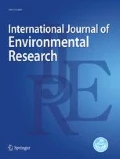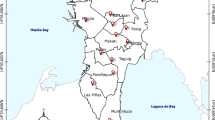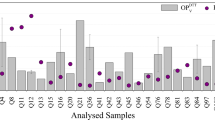Abstract
Particulate matter has dangerous impacts on human health, environment and economy. Recently, dust storms coming from Arab countries have drastically increased, and affect the western and central parts of Iran. The aim of the present study is to investigate the annual and seasonal changes in meteorological parameters associated with the occurrence of dust storms, physical and chemical properties of airborne dust over Ahvaz city during the warm period in 2010. Particle size distribution analyses were conducted by using the laser size analysis techniques. Chemical compositions are measured with different techniques such as X-ray fluorescence, atomic absorption spectrophotometer, and X-ray diffraction. Also, the level of heavy metal contamination in the dust samples was determined using enrichment factor. A disagreement between the occurrences of dust storms, temperature, relative humidity, and rainfall shows the major source of dust storms over Ahvaz city was from the neighboring countries. Scanning electron microscope analyses of dust samples show that airborne dust has rounded irregular, angular and jagged shapes. The sizes of dust particles vary from 0.1 to 55 μm, but PM10 is the dominant particle size. The chemical and mineralogical analysis of dust particles, with major contribution of SiO2, Al2O3, and CaO indicated the likely origin of these particles is the countries neighboring southwest of Iran. Also, the detected trace elements of Br, Mo, S, Zn, Ni, Cr, Co and Hg had non-crustal sources. Generally, airborne dusts in Ahvaz city are geochemically much the same as dust samples in other parts of the world.





Similar content being viewed by others
Notes
Reactive oxygen species.
Mitochondrial membrane potential.
References
Abdovis M, Bahrami H, Darvishi A (2012) Correlation between climatic parameters with the occurrence of dust storms in Khuzestan province. Paper presented at 1st international congress dealing with the phenomenon of dust and its harmful effects, Ahvaz, 15–16 Feb 2012
Ashrafi K, Shafiepour-Motlagh M, Aslemand AR, Ghader S (2014) Dust storm simulation over Iran using HYSPLIT. J Environ Health Sci Eng 12:9
Broomandi P, Bakhtiarpoor A (2016) Dust source identification using physical–chemical characterization and numerical modeling over Masjed Soleyman. Iran J Health Environ 9(4):517–526
Broomandi P, Dabir B, Bonakdarpour B, Rashidi Y (2016) Source identification of Dust storm events over Ahvaz city by HYSPLIT. J Pollut 3(2):341–348
Engelbrecht JP, McDonald EV, Gillies JA, Jayanty RKM, Casuccio G, Gertler AW (2009) Characterizing mineral dusts and other aerosols from the Middle East—Part 1: ambient sampling. Inhal Toxicol 21:297–326
Givehchi R, Arhami M (2013) Contribution of the Middle Eastern dust source areas to PM10 levels in urban receptors: case study of Tehran, Iran. Atmos Environ 75:287–295
Goudie AS, Middleton NJ (2001) Saharan dust storms: nature and consequences. Earth-Sci Rev 56:179–204
Goudie AS, Middleton NJ (2006) Desert dust in global systems. Springer, Heidelberg, p 287
Hojati S, Khademi H, Cano AF, Landi A (2012) Characteristics of dust deposited along a transect between central Iran and the Zagros Mountains. Catena 88(1):27–36
Hoornaert S, Godoi RHM, Van Grieken R (2004) Elemental and single particle aerosol characterization at a background station in Kazakhstan. J Atmos Chem 48:301–315
IR.DOE data (2016) Ahvaz air pollution monitoring stations datasets. Department of Environment, Tehran
Mehrabi SS, Jafari R (2015) The relationship between climatic parameters and the occurrence of 278 dust (case study: Khozestan province of Iran). J Water Soil Sci 19(71):69–81 (In Persian)
Meza-Figueroa D, O-Villanueva MD, Parra MLD (2007) Heavy metal distribution in dust from elementary schools in Hermosillo, Sonora, Mexico. Atmos Environ 41:276–288
Miri A, Ahmadi H, Ghanbari A, Moghaddamnia AL (2007) Dust storms impacts on air pollution and public health under hot and dry climate. Int J Energy Environ 1:2
Nastagdori L, Jugder D, Schung Y (2003) Analysis of dust storms observed. Mongolia during 1937–1999. Atmos Environ 37:1401–1411
Power MC (1953) A new roundness scale for sedimentary particles. J Sediment Petrol 23:117–119
Rashki A, Eriksson PG, Rautenbach CJdeW, Kaskaoutis DG, Grote W, Dykstra J (2013) Assessment of chemical and mineralogical characteristics of airborne dust in the Sistan region, Iran. J Chemosphere 90:227–236
Reynolds RL, Cattle SR, Moskowitz BM, Goldstein HL, Yauk K, Flagg CB, Berquó TS, Kokaly RF, Morman S, Breit GN (2014) Iron oxide minerals in dust of the Red Dawn event in eastern Australia, September 2009. Aeolian Res 15:1–13
Rezaei M, Salimi A, Taghidust M, Naserzadeh P, Goudarzi GR, Seydi E, Pourahmad J (2014) A comparison of toxicity mechanisms of dust storm particles collected in the southwest of Iran on lung and skin using isolated mitochondria. Toxicol Environ Chem 96:814–830
Rodríguez IE, Galí S, Marcos C (2009) Atmospheric inorganic aerosol of a nonindustrial city in the centre of an industrial region of the North of Spain, and its possible influence on the climate on a regional scale. Environ Geol 56:1551–1561
Taylor SR, McLennan SM (1995) The geochemical evolution of the continental crust. Rev Geophys 33(2):241–265
Usher CR, Michel AE, Grassian VH (2003) Reactions on mineral dust. Chemical Rev 103:4883–4940
WHO (2006) Air quality guidelines: global update 2005: particulate matter, ozone, nitrogen dioxide and sulfur dioxide. WHO Regional Office for Europe, Copenhagen, p 2006
Wu G, Xu B, Zhang C, Gao S, Yao T (2009) Geochemistry of dust aerosol over the Eastern Pamirs. Geochim Cosmochim Acta 73:977–989
Zarasvandi A, Carranza EJM, Moore F, Rastmanesh F (2011) Spatio-temporal occurrences and mineralogical–geochemical characteristics of airborne dusts in Khuzestan Province (southwestern Iran). J Geochem Explor 111:138–151
Author information
Authors and Affiliations
Corresponding author
Rights and permissions
About this article
Cite this article
Broomandi, P., Dabir, B., Bonakdarpour, B. et al. Mineralogical and Chemical Characterization of Suspended Atmospheric Particles in Ahvaz. Int J Environ Res 11, 55–62 (2017). https://doi.org/10.1007/s41742-017-0006-6
Received:
Accepted:
Published:
Issue Date:
DOI: https://doi.org/10.1007/s41742-017-0006-6




